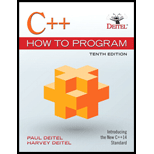
To Determine:
Definition for each of the following:
- Structure inventory, containing character array part name [30], integer part number, floating-point price, integer stock and integer reorder.
- A structure called address that contains character arrays street address [25], city [20], state [3] and zipcode [6].
- Structure student, containing arrays first name [15] and last name [15] and variable home address of type struct address from part (b).
- Structure test, containing 16 bit fields widths of 1 bit. The names of the bit fields are the letters a to p.
Explanation of Solution
Explanation:
Defining Structures:
Structure is nothing but the collection of different variables of different types. First we need to define a structure in the program, for that we need to use the keyword struct and then the name of the structure. The name under which we want to combine different-different variables or different-different elements and between the curly braces whatever we write or whatever variables we declare will be considered as the members of the structure. All the members will be available under this one name of the structure. Declaring or defining the member of a structure is similar to the way we declare the variables.
- Here we are storing the information of Inventory, so the structure name will be Inventory and all the members are available under this one name Inventory.
- Here we are storing the information of Address, so the structure name will be Address and all the members are available under this one name Address.
- Here we are storing the information of Student, so the structure name will be Student and all the members are available under this one name Student.
- Here we are storing the information of Test, so the structure name will be Test and all the members are available under this one name Test.
structInventory
{
charpartName[30];
intpartNumber;
floatprice;
intstock;
intrecorder;
};
structAddress
{
charstreetAddress[25];
charcity[20];
charstate[3];
charzipCode[6];
};
structStudent
{
charfirstName[15];
charlastName[15];
struct
{
charstreetAddress[25];
charcity[20];
charstate[3];
charzipCode[6];
}
homeAddress;
};
structTest
{
boola:1, b:1, c:1, d:1, e:1, f:1, g:1, h:1,
i:1, j:1, k:1, l:1, m:1, n:1, o:1, p:1;
};Want to see more full solutions like this?
Chapter 22 Solutions
C++ How To Program Plus Mylab Programming With Pearson Etext -- Access Card Package (10th Edition)
- 15 OF 25 QUESTIONS REMAININ Consider the following code. You want to print the array values in the div as an ordered list. What statement would you use to replace the comment in the code below? Two J // what statement goes here? - لبية للالكالا const app = Vue.createApp({ data (( return ( lunch: [ 'Burrito', 'Soup', 'Pizza', 'Rice' }) app.mount ('#app6') - -arrow_forwardPlease answer JAVA OOP problem below: Assume you have three data definition classes, Person, Student and Faculty. The Student and Faculty classes extend Person. Given the code snippet below, in Java, complete the method determinePersonTypeCount to print out how many Student and Faculty objects exist within the Person array. You may assume that each object within the Person[] is either referencing a Student or Faculty object. public static void determinePersonTypeCount(Person[] people){ // Place your code here }arrow_forwardPlease answer JAVA OOP question below: Consider the following relationship diagram between the Game and VideoGame data defintion classes. Game has a constructor that takes in two parameters, title (String) and cost (double). The VideoGame constructor has an additional parameter, genre (String). In Java, efficiently write the constructors needed within the Game class and VideoGame classes. Hint: Remember to think about the appropriate validationarrow_forward
 C++ for Engineers and ScientistsComputer ScienceISBN:9781133187844Author:Bronson, Gary J.Publisher:Course Technology Ptr
C++ for Engineers and ScientistsComputer ScienceISBN:9781133187844Author:Bronson, Gary J.Publisher:Course Technology Ptr C++ Programming: From Problem Analysis to Program...Computer ScienceISBN:9781337102087Author:D. S. MalikPublisher:Cengage Learning
C++ Programming: From Problem Analysis to Program...Computer ScienceISBN:9781337102087Author:D. S. MalikPublisher:Cengage Learning EBK JAVA PROGRAMMINGComputer ScienceISBN:9781337671385Author:FARRELLPublisher:CENGAGE LEARNING - CONSIGNMENT
EBK JAVA PROGRAMMINGComputer ScienceISBN:9781337671385Author:FARRELLPublisher:CENGAGE LEARNING - CONSIGNMENT- Programming Logic & Design ComprehensiveComputer ScienceISBN:9781337669405Author:FARRELLPublisher:Cengage
 Microsoft Visual C#Computer ScienceISBN:9781337102100Author:Joyce, Farrell.Publisher:Cengage Learning,
Microsoft Visual C#Computer ScienceISBN:9781337102100Author:Joyce, Farrell.Publisher:Cengage Learning,




